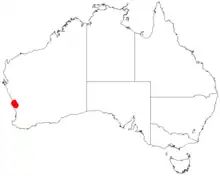Acacia epacantha
Acacia epacantha is a shrub of the genus Acacia and the subgenus Pulchellae that is endemic to an area in the south west of Australia.
| Acacia epacantha | |
|---|---|
| Scientific classification | |
| Kingdom: | Plantae |
| Clade: | Tracheophytes |
| Clade: | Angiosperms |
| Clade: | Eudicots |
| Clade: | Rosids |
| Order: | Fabales |
| Family: | Fabaceae |
| Subfamily: | Caesalpinioideae |
| Clade: | Mimosoid clade |
| Genus: | Acacia |
| Species: | A. epacantha |
| Binomial name | |
| Acacia epacantha | |
 | |
| Occurrence data from AVH | |
| Synonyms | |
|
Acacia lasiocarpa var. epacantha (Maslin) Racosperma epacanthum (Maslin) | |
Description
The dense bushy spiny shrub typically grows to a height of 0.2 to 0.5 metres (0.7 to 1.6 ft)[1] and has a spreading habit with branchlets that have axillary 1 to 2 cm (0.39 to 0.79 in) long spines that around found singly on each node. The single pair of pinnae have a length of 1 to 2 mm (0.039 to 0.079 in) and have two pairs of pinnules with a length of 6 to 10 mm (0.24 to 0.39 in) and a width of 0.7 to 1.5 mm (0.028 to 0.059 in).[2] It blooms from July to August and produces yellow flowers.[1]
It is closely related to Acacia fagonioides, and they are the members of Acacia pulchella group.[2]
Taxonomy
The species was first formally described by the botanist Bruce Maslin in 1979 as a part of the work Studies in the genus Acacia (Mimosaceae) - 9 Additional notes on the Series Pulchellae Benth. as published in the journal Nuytsia. It was reclassified as Racosperma epacanthum in 2003 by Leslie Pedley then transferred back to genus Acacia in 2006.[3]
Distribution
It is native to an area on the west coast in the Wheatbelt region of Western Australia where it is commonly found growing in gravelly lateritic loam or clay soils.[1]
See also
References
- "Acacia epacantha". FloraBase. Western Australian Government Department of Biodiversity, Conservation and Attractions.
- "Acacia epacantha". World Wide Wattle. Western Australian Herbarium. Retrieved 4 February 2021.
- "Acacia epacantha (Maslin) Maslin". Atlas of Living Australia. Global Biodiversity Information Facility. Retrieved 4 February 2021.

